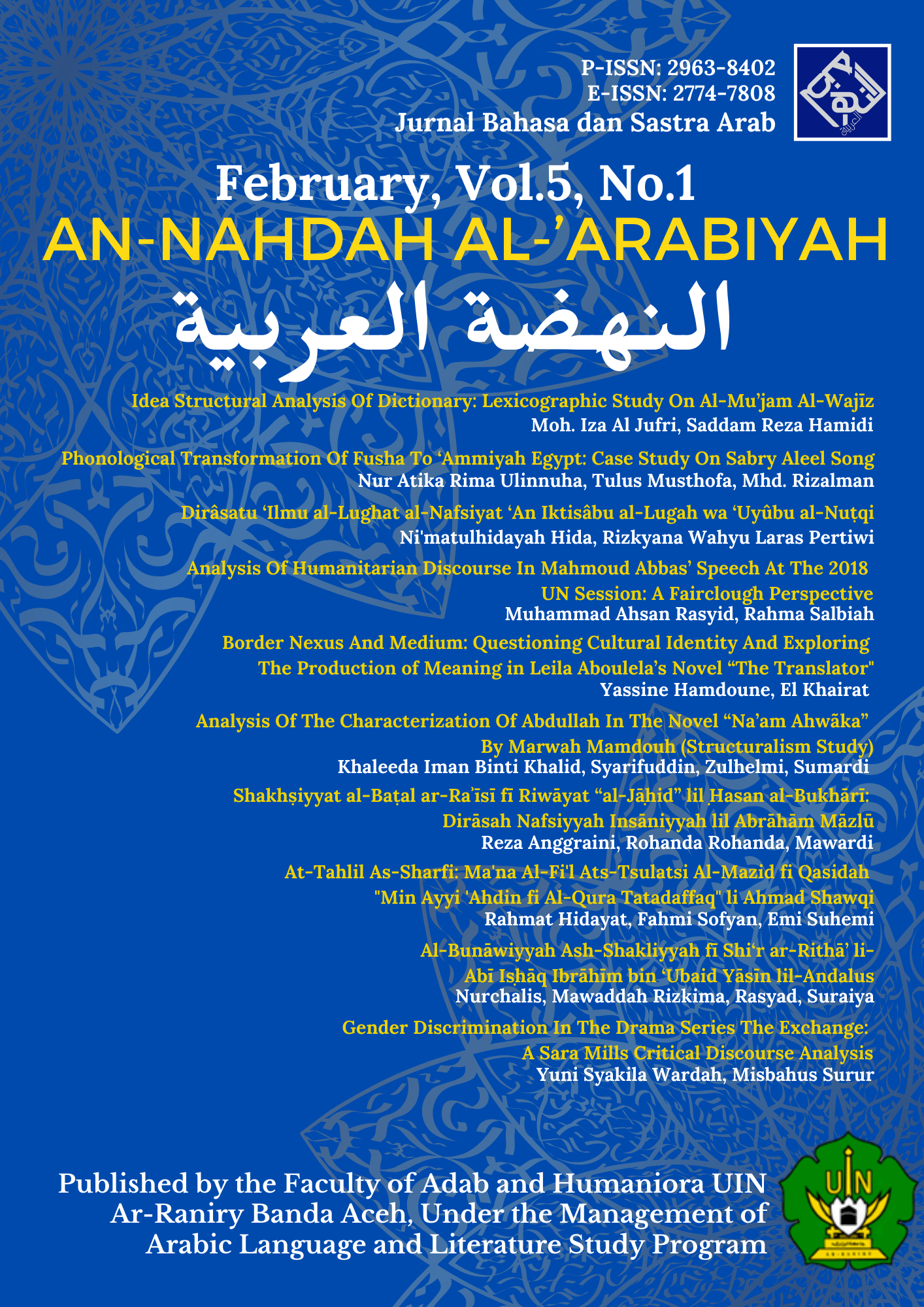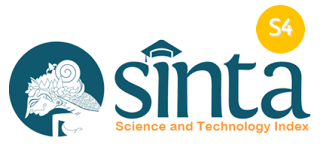Idea Structural Analysis Of Dictionary: Lexicographic Study On Al-Mu’jam Al-Wajīz
At-Tahlīl al-Binyawī li al-Afkār fī al-Ma‘ājim: Dirāsah Ma‘ājimiyyah li Kitāb al-Mu‘jam al-Wajīz
DOI:
https://doi.org/10.22373/nahdah.v5i1.4930Keywords:
Al-Mu’jam Al-Wajīz, Lexicography, Ideal dictionary, 'Ilmu Mu'jam, Qamus Al-Mistali, Leksikografi, Kamus idealAbstract
In The era of information technology, dictionaries play an important role in language studies, including Al-Mu’jam Al-Wajīz. This dictionary has an important role, especially in the study of Arabic terms in the modern era. The aims of this research are: First, what is the identity and typology of Al-Mu’jam Al-Wajīz. Second, what are the completeness components of the dictionary in Al-Mu’jam Al-Wajīz. This study uses a qualitative descriptive approach. Primary data were obtained from Al-Mu’jam Al-Wajīz, while secondary data came from lexicography books, research journals, theses, and other relevant scientific articles. Data collection techniques were carried out through reading and recording sources related to the research topic. Data analysis was carried out through the stages of data reduction, data presentation, and drawing conclusions. The results of this research are based on an analysis of the completeness component of Dr. Ali Al-Qasimy revealed that Al-Mu’jam Al-Wajīz has fulfilled 21 components of the 27 components of the completeness of the dictionary. This shows that most of the completeness components of Al-Mu’jam Al-Wajīz have been fulfilled and can be said to have an ideal dictionary structure. This research can be used as reference material, notes or comparisons for developments in compiling Arabic dictionaries in the modern era.
في عصر تكنولوجيا المعلومات، تلعب المعاجم دورًا مهمًا في دراسة اللغة، بما في ذلك المعجم الوجيز. ويحتل هذا المعجم مكانة بارزة، خاصة في دراسة المصطلحات العربية في العصر الحديث. تهدف هذه الدراسة إلى: أولًا، تحديد هوية ونمط المعجم الوجيز. ثانيًا، تحليل مكونات اكتمال المعجم في المعجم الوجيز. تعتمد هذه الدراسة على منهج وصفي نوعي. تم الحصول على البيانات الأولية من المعجم الوجيز، بينما جاءت البيانات الثانوية من كتب المعاجم، والمجلات البحثية، والرسائل العلمية، والمقالات العلمية الأخرى ذات الصلة. تم جمع البيانات من خلال القراءة وتسجيل المصادر المتعلقة بموضوع البحث. وتم تحليل البيانات عبر مراحل تقليل البيانات، وعرض البيانات، واستخلاص النتائج. كشفت نتائج هذه الدراسة، بناءً على تحليل مكونات اكتمال المعجم وفقًا للدكتور علي القاسمي، أن المعجم الوجيز قد استوفى 21 مكونًا من أصل 27 مكونًا من مكونات اكتمال المعجم. وهذا يدل على أن معظم مكونات اكتمال المعجم الوجيز قد تحققت، مما يجعله معجمًا ذا هيكل مثالي. يمكن أن تُستخدم هذه الدراسة كمصدر مرجعي أو ملاحظات أو مقارنة لتطوير إعداد المعاجم العربية في العصر الحديث.
Dalam era teknologi informasi, kamus memainkan peran penting dalam kajian bahasa, termasuk Al-Mu’jam Al-Wajīz. Kamus ini memiliki peran yang signifikan, terutama dalam studi istilah-istilah Arab di era modern. Penelitian ini bertujuan untuk: Pertama, mengidentifikasi identitas dan tipologi Al-Mu’jam Al-Wajīz. Kedua, menganalisis komponen kelengkapan kamus dalam Al-Mu’jam Al-Wajīz. Penelitian ini menggunakan pendekatan deskriptif kualitatif. Data primer diperoleh dari Al-Mu’jam Al-Wajīz, sedangkan data sekunder berasal dari buku-buku leksikografi, jurnal penelitian, tesis, dan artikel ilmiah lain yang relevan. Teknik pengumpulan data dilakukan melalui membaca dan mencatat sumber-sumber yang berkaitan dengan topik penelitian. Analisis data dilakukan melalui tahapan reduksi data, penyajian data, dan penarikan kesimpulan. Hasil penelitian ini, berdasarkan analisis komponen kelengkapan kamus menurut Dr. Ali Al-Qasimy, mengungkapkan bahwa Al-Mu’jam Al-Wajīz telah memenuhi 21 dari 27 komponen kelengkapan kamus. Hal ini menunjukkan bahwa sebagian besar komponen kelengkapan dalam Al-Mu’jam Al-Wajīz telah terpenuhi, sehingga dapat dikatakan memiliki struktur kamus yang ideal. Penelitian ini dapat dijadikan sebagai bahan referensi, catatan, atau perbandingan dalam pengembangan penyusunan kamus bahasa Arab di era modern.
References
Agussalim, A., Sanusi B., Y., & Zuhriah, Z. (2019). Design of a Windows- Arabic-Arabic Linguistic-Based Digital Dictionary. Nady Al-Adab, 16(2), 75–88. https://doi.org/10.20956/jna.v16i2.6657
Ahya, M. (2023). Development of Science Pictorial Dictionary Media in Class V MIN 11 Pidie Jaya [Ar-Raniry State Islamic University]. https://doi.org/https://repository.ar-raniry.ac.id/id/eprint/26585/
Anis, I., Alhufi, A.M., Nasif, A.N., & Ahmad, M. A. A. (2012). Al-Mu'Jam Al-Wajiz (3 Revisi). Ayuruq Addauliyah.
Aryobimo, B. (2023). Development of a Thematic Arabic Dictionary: Validity, Feasibility, and Effectiveness (A. Sopian & M. Abdurrahman (ed.); 1 ed.). Nas Media Pustaka.
Fadhilah, M. A. (2021). Analisis Karakteristik Aplikasi Kamus Arab-Indonesia Karya Tim Ristek Muslim. Alsina : Journal of Arabic Studies, 3(2), 201–218. https://doi.org/https://journal.walisongo.ac.id/index.php/alsina/article/view/5938
Fathanah, K., Bigadaran, S., Hasan, N., & Wargadinata, W. (2021). The Use of the Musa'id Lil Arabiyah Baina Yadaik Dictionary as a Learning Media for Female Students in the First Semester of STAI As-Sunnah Medan Academic Year 2019. Shaut al Arabiyyah, 9(1), 61–68. https://doi.org/https://journal.uin-alauddin.ac.id/index.php/Shautul-Arabiyah/article/view/20019
Hafidz, M. (n.d.). The gathering of al-Lagha al-'Arabiyya majz' is historical and an integral part of it. Maktaba Siamla Ad-Dazhabiyya. Hits://doi.org/hatps:/ww.shimila.vis/
Harun, U. B. (2019). Analysis of the Components of Al-Mufied Indonesian-Arab Perspective Dr. Ali Al-Qasimy. Proceedings of the National Conference on Arabic V, 8(2), 639–647. https://doi.org/https://prosiding.arab-um.com/index.php/konasbara/article/view/531/490
Haryati, R., Berliani, D., Hilmi, M., & Hasaniyah, N. (2023). Analysis of the Typology of Mobile Dictionary "Al-Kamus" with a Lexigraphic Approach. Al Mi'yar: Scientific Journal of Arabic Language Learning and Arabic Language, 6(2), 815–834. https://doi.org/https://www.jurnal.stiq-amuntai.ac.id/index.php/al-miyar/article/view/2525/pdf
Hayani, F. (2019). Arabic Lexicography (A Study of Applied Linguistics). Shaut al Arabiyyah, 7(1), 1–12. https://doi.org/10.24252/saa.v1i1.7786
Hidayah, N., & Qomariah, U. K. (2020). Science Thematic Dictionary as an Effort to Improve Arabic Vocabulary Mastery of Biology Students. AL-Lahjah Journal of Education, Arabic Language and Arabic Linguistic Studies, 5(2), 20–28. https://doi.org/https://ejournal.unwaha.ac.id/index.php/lahjah/article/view/886
Huda, N., & Ulfah, N. (2019). Development of Arabic-Indonesian Dictionary as a Support for the Use of Madrasah Tsanawiyah Textbooks in Class VIII. alfazuna: Journal of Arabic Language and Arabic Language Learning, 3(2), 211–230. https://doi.org/10.15642/alfazuna.v3i2.533
Ilham, R. N. (2023). The Utilization of Arabic-Indonesian Digital Dictionary as a Learning Resource at Ibnu Khaldun IT Junior High School. Journal of Educational Research, 4(4), 1927–1937 https://doi.org/https://doi.org/10.37985/jer.v4i4.632
Irawati. (2021). Analysis of the Lexicology of Term 'Afā, Ṣafaḥa and Gafara Perspektif Tafsir Al-Mishbᾱh [State Islamic Religious Institute (IAIN) Madura]. https://doi.org/http://etheses.iainmadura.ac.id/1846/
Karomah, N., & Al Anshory, A. M. (2022). The Use of Arabic Dictionary as a Learning Media for Maharah Kalam at Al-Chodijah Integrated Junior High School Jombang. Shaut al Arabiyyah, 10(2), 300–310. https://doi.org/https://journal.uin-alauddin.ac.id/index.php/Shautul-Arabiyah/article/view/34201
Moleong, L. J. (2016). Qualitative Research Methodology (35 ed.). PT Remaja Rosdakarya.
Mubarak, M. H. (2012). Arabanisasi. Jurnal Ilmiah Iqra’, 6(1). https://doi.org/https://journal.iain-manado.ac.id/index.php/JII/article/view/614/517
Nasarudin, N. (2020). The Use of Bilingual Dictionary as a Learning Resource in Mastering Arabic Vocabulary of Students of the Faculty of Law, University of Muhammadiyah Mataram. Proceedings of the National Seminar on Research and Community Service, 1(1), 229–240. https://doi.org/10.24967/psn.v1i1.828
Nasyithoh, S. G. N., Aini, S. M. N., Thayyib, T., & Huda, M. M. (2021). Perspektif Dr. Ali Al-Qasmy pada Kamus Akbar Bahasa Arab (Indonesia-Arab). Shaut al Arabiyyah, 9(2), 233–244. https://doi.org/10.24252/saa.v9i2.24202
Nuha, U. (2024). The Use of Arabic-Indonesian Dictionary as a Support for the Arabic Learning Process at Madrasah Aliyah Al-I ' anah Playen Gunungkidul. Al-Mashadir Scientific Journal:Journal of Arabic Education and Literature, 4(1), 1–17. https://doi.org/https://ejournal.iain-manado.ac.id/index.php/almashadir/article/view/914
Ramadhan, S., Fauzi, F., Aida, N., Permata Sari, D. M., & Anggraini, G. (2020). Maintaining the Existence of the Preservation of the Sampit Language during the Pandemic with Sampit Customary and Cultural Institutions. ABDIMAS: Journal of Community Service, 3(2), 360–366. https://doi.org/10.35568/abdimas.v3i2.974
Sujarno. (2016). Indonesian Lexicography: Basic Concepts, Functions, Contents, and Types of Dictionaries. Innovation, 18(1), 49–58. https://doi.org/file:///C:/Users/ACER/Downloads/588-1526-1-SM.pdf
Taufiqurrochman. (2015). Arabic Lexicology (M. Faisol (ed.); 2 ed.). UIN Malang-PRESS.
Zahrah, H., Wargadinata, W., & Barry, N. A. (2021). Analysis of "Arab-Indonesian" E-Dictionary Available on Playstore with Lexicologic Approach. Shaut al-Arabiyyah, 9(1), 1. https://doi.org/10.24252/saa.v9i1.21494
Sofyan, Z., Fajri, A., Sumardi, S., Zulhelmi, A., Shaliha, C. A. A., & Yasir, M. (2024). How motivation enables polyglots to acquire foreign languages. Diksi, 32(1), 153-168.
Sumardi, S., Trisnady, I. A., & Sofyan, Z. (2024). Balaghah Ar-Ritsa’Fii Syair Al-Khanasa’Min Nihayah Al-Lafdhi Wa Al-Ma’ani. An-Nahdah Al-'Arabiyah, 4(1), 56-67.






1.png)

